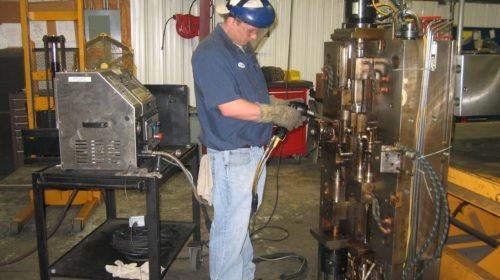THE SITUATION
In business for over 150 years, the chocolate company is a manufacturer and marketer of premium chocolates and chocolate products. They control the entire chocolate manufacturing process, from cocoa bean to finished product. This control over the manufacturing process, combined with their proprietary bean blend and unique methods of roasting and processing, ensure the highest quality and richest chocolate products.
THE PROBLEM
One of the issues the company grapples with in its manufacturing process is deploying cleaning solutions that are efficient, safe and help maintain clean, allergen free environments for continuous manufacturing. When it comes to manufacturing the world’s finest chocolates, this company emphasizes even the minutest details. Ensuring that non-nut containing products do not contain nuts, for example, is a critical concern for the company, as well as its consumers who have come to rely on them for quality. The company’s traditional cleaning methods included manually scraping chocolate and food particulates from chains and rails on its production line using brushes and scrapers. The process was time consuming and tedious, and required that the company shutdown production and allocate extensive resources. With new product lines to launch and a high standard of profitability, the company has been looking for ways to implement cleaning methods that will reduce people resources and time while still maintaining a safe, clean and allergen-free manufacturing environment.
In an effort to enhance its cleaning process, the company decided to evaluate new cleaning methods and systems. This chocolate company isn’t willing to cut corners so it needed a cleaning solution that is reliable, efficient, easy to use and that provided the level of cleanliness that the company needed to manufacture multiple, independent food products. In addition, whatever method or system they selected, it needed to help the company increase profitability with its new product lines, rather than add to any production costs. Among the processes the company researched was steam cleaning, which used portable steamers and custom made brushes and scrapers. However, while they were effective in cleaning the equipment, the steamers proved to be inefficient. The company also evaluated several different makes and models of other alternative cleaning systems, including those which utilized dry ice.
“We are committed to lean manufacturing and our manual clean-up process was both time consuming and inefficient,” said the Production Supervisor. “Our allergen cleanup process required up to 500 man hours at times to ensure that we were operating an allergen-free and safe work environment. We needed a new solution that was more efficient and provided the environment that is required to produce the variety and breadth of products that we manufacture. We looked at a lot of solutions, and ultimately, Cold Jet’s dry ice cleaning systems proved to be the best.”
THE SOLUTION
In one of the closely monitored initial trials using Cold Jet’s Aero 40 system, the company was able to reduce its clean-up time by more than 60 percent. In addition to saving time and people resources, the production team found the system to be user-friendly and a complement to their lean manufacturing initiatives.
“It’s not easy to cut clean-up costs without cutting corners but when working with food, you simply don’t take risks,” commented the Production Supervisor. “Nut allergies are a huge problem today, and we don’t take that issue lightly. That’s why we decided to implement a Cold Jet cleaning system.”
Following the initial pilot test, the company deployed three Cold Jet Aero 40 systems, which deliver advanced economical dry ice cleaning in an environmentally responsible format. The Aero 40 is a compact, rugged, mobile solution that allows them to clean their chocolate and candy production equipment in place and while it is still hot and online. With fewer people required to clean and the ability to clean in less time, they have been able to reduce their maintenance costs and production downtime. A faster, more effective clean allows the company to increase the number of production cycles using the same equipment.
The environmentally responsible dry ice cleaning process uses recycled CO2 in the form of dry ice pellets. The pellets are accelerated at supersonic speeds using compressed air and the combination of the velocity and the thermal gradient of the dry ice removes the contaminants from the surface of the equipment. Once the dry ice strikes the surface of the conveyors, chains and other equipment, it sublimates, leaving nothing to clean up except the removed contaminants. Dry ice cleaning is also non-abrasive and non-conductive, which means the company can use the system without worrying about the wear and tear on equipment or damaging electronic components. Dry ice cleaning has also been effectively used in EPA, FDA and USDA inspected facilities.
“We tried different models of dry ice cleaners, but eventually all agreed that the units from Cold Jet were easier to use and more effective,” said the Production Supervisor. “The Aero 40 machines are fast, efficient, non-toxic and non-abrasive. My production team tells me repeatedly that Cold Jet’s product is user-friendly and that it has the best applicator nozzle and attachment of all those that we evaluated. Did I mention they are fast? The Aero systems give us everything we asked for in a cleaning solution, and I’m getting a lot of interest from other plants within our organization because of the efficiency and the production increases we’ve achieved. Cold Jet has helped us become a better, cleaner manufacturer and the dry ice cleaning system truly adds value to our organization’s operations.”
By deploying Cold Jet’s cleaning systems, the company has reduced the time and resources it takes to complete the company’s extensive allergen cleanup process. As a result, they have enhanced its lean initiatives and deployed a cleaning solution that actually helps increase production and profitability.
The company is currently looking to expand its use of dry ice cleaning to other departments and possibly other plants within its family of companies.




